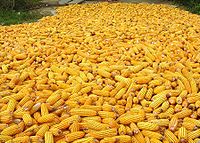Maize (color)
| Maize | |
|---|---|
| Hex triplet | #FBEC5D |
| sRGBB (r, g, b) | (251, 236, 93) |
| HSV (h, s, v) | (54°, 63%, 98%) |
| CIELChuv (L, C, h) | (92, 86, 79°) |
| Source | Maerz and Paul[1] |
| ISCC–NBS descriptor | Brilliant greenish yellow |
| B: Normalized to [0–255] (byte) | |

The shade maize or corn refers to a specific tone of yellow; it is named for the cereal of the same name—maize (called corn in the United States and Canada). In public usage, maize can be applied to a variety of shades, ranging from light yellow to a dark shade that borders on orange, since the color of maize (the actual corn) may vary.
The first recorded use of maize as a color name in English was in 1861.[2]
Usage
- "Light maize in color, this wildflower is found only now and then in our area, and treasured for its rarity. The three clumps, two near the east fence under a thriving red-stemmed dogwood and one beside a weathered stump, gave us a thrill last spring with their first buds."[3]
- "For slow cases, one can use the method... in which a solution of thymol blue has had its pH value adjusted so that it is maize in color and any slight increase in the acidity will make the solution turn blue."[4]
- Maize is one of the two colors used by the University of Michigan Wolverines (the other being blue) although the actual shade of yellow used has varied over time; however, it always approaches the color of corn.[5] The athletic colors of Carleton College are also maize and blue.
See also
References
- ^ The color displayed in the color box above matches the color called maize in the 1930 book by Maerz and Paul A Dictionary of Color New York:1930 McGraw-Hill; the color maize is displayed on page 43, Plate 10, Color Sample G5.
- ^ Maerz and Paul A Dictionary of Color New York:1930 McGraw-Hill Page 198; Color Sample of Maize: Page 43 Plate 10 Color Sample G5
- ^ Rodale, Jerome Irving (1965). Organic gardening. Rodale Press. p. 54.
- ^ Debler, Walter R. (1990). Fluid Mechanics Fundamentals. Prentice Hall. p. 615. ISBN 978-0-13-322371-2.
- ^ Liene Karels (Fall 1996). "What colors are maize and blue?". Michigan Today. Archived from the original on December 20, 1996. Retrieved September 5, 2015.
